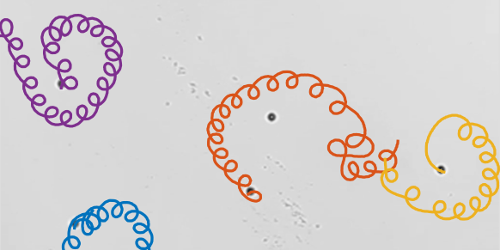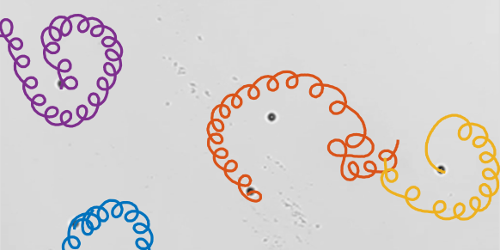Tiny Droplets Do the Twist
Self-propelled biological systems are common—think sperm. But the microscopic architecture of such natural swimmers is complicated, and their motion is hard to predict. Designing motile, controllable swimmers would allow researchers to create biologically inspired systems and potentially harness their collective, large-scale behavior. Now, a team of scientists led by Corinna Maass at the Max Planck Institute for Dynamics and Self-Organization in Germany has shown that the motion of artificial microswimmers can be modulated by simply altering the temperature of their liquid bath.
Maass and her colleagues placed tiny liquid-crystal droplets in a soap solution that lowered the surface tension of the droplets. Gradients in the surface tension generated flows in the interface between the solution and the droplets that propelled the droplets at speeds of up to roughly 1 meter per hour. The researchers showed that the alignment of molecules within each droplet furthermore resulted in rotational torques that caused the droplets to trace out tiny two-dimensional circles in their bath. This curling effect could be systematically and reversibly modulated with temperature: When the droplets were heated to such that their molecules became disordered, the rotational torques ceased and the droplets moved without curling. Maass and her team also demonstrated that the droplets tended to avoid their own trajectories. In experiments in which the specific gravity of the droplets was modified, this self-avoidance caused neutrally buoyant droplets to twist into three-dimensional helical paths. Many biological swimmers exhibit similar helical instabilities that can be exploited to navigate or forage for food. These droplets offer a conceptually simple, easily tunable system to be used in comparative studies.
This research is published in Physical Review Letters.
–Katherine Kornei
Katherine Kornei is a freelance science writer based in Portland, Oregon.





